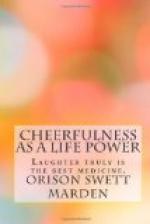“It is not work that kills men,” says Beecher; “it is worry. Work is healthy; you can hardly put more on a man than he can bear. But worry is rust upon the blade. It is not movement that destroys the machinery, but friction.”
It is not so much the great sorrows, the great burdens, the great hardships, the great calamities, that cloud over the sunshine of life, as the little petty vexations, insignificant anxieties and fear, the little daily dyings, which render our lives unhappy, and destroy our mental elasticity, without advancing our life-work one inch. “Anxiety never yet bridged any chasm.”
“What,” asks Dr. George W. Jacoby, in an “Evening Post” interview, “is the ultimate physical effect of worry? Why, the same as that of a fatal bullet-wound or sword-thrust. Worry kills as surely, though not so quickly, as ever gun or dagger did, and more people have died in the last century from sheer worry than have been killed in battle.”
Dr. Jacoby is one of the foremost of American brain doctors. “The investigations of the neurologists,” he says, “have laid bare no secret of Nature in recent years more startling and interesting than the discovery that worry kills.” This is the final, up-to-date word. “Not only is it known,” resumes the great neurologist, counting off his words, as it were, on his finger-tips, “that worry kills, but the most minute details of its murderous methods are familiar to modern scientists. It is a common belief of those who have made a special study of the science of brain diseases that hundreds of deaths attributed to other causes each year are due simply to worry. In plain, untechnical language, worry works its irreparable injury through certain cells of the brain life. The insidious inroads upon the system can be best likened to the constant falling of drops of water in one spot. In the brain it is the insistent, never-lost idea, the single, constant thought, centered upon one subject, which in the course of time destroys the brain cells. The healthy brain can cope with occasional worry; it is the iteration and reiteration of disquieting thoughts which the cells of the brain cannot successfully combat.
“The mechanical effect of worry is much the same as if the skull were laid bare and the brain exposed to the action of a little hammer beating continually upon it day after day, until the membranes are disintegrated and the normal functions disabled. The maddening thought that will not be downed, the haunting, ever-present idea that is not or cannot be banished by a supreme effort of the will, is the theoretical hammer which diminishes the vitality of the sensitive nerve organisms, the minuteness of which makes them visible to the eye only under a powerful microscope. The ‘worry,’ the thought, the single idea grows upon one as time goes on, until the worry victim cannot throw it off. Through this, one set or area of cells is affected. The cells are intimately connected, joined together by little fibres, and they in turn are in close relationship with the cells of the other parts of the brain.




